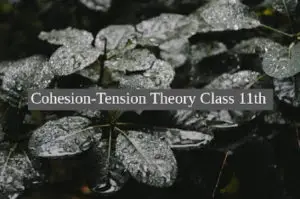If you have read about transpiration you must have come across a theory called “cohesion-tension theory”. This theory might seem difficult at first when you read the title but no need to worry about it. In this article I will make sure to explain this theory in simple terms.
Table of Contents
What is Cohesion-Tension Theory ?
The cohesion-tension theory was developed by H. Dixon and John Joly in 1914. It is a widely accepted theory which operates in passive absorption. This is a theory of ascent of sap (climbing of water molecules and minerals).
Passive absorption is a physical process where the minerals from the soil are absorbed without spending any energy on the part of the root cells. This takes place by diffusion, direct ion exchange, indirect ion exchange and by mass flow.
This theory is based on three principle factors which are as follows:
- There is presence of strong cohesion force between the water molecules in the water column.
- Adhesive force exists between the water column and the cell wall.
- There is a presence of transpiration pull in the unbroken water column.
Now this must all sound really confusing and to make it simpler wcohesione are going to know about it individually.
Cohesion:
Water molecules are attached to each other via H-bonds but these bonds are weak. Since they are many in numbers like in the case of water, they tend to create a strong mutual force of attraction which is called as cohesion (attracts similar molecules). This force of attraction keeps the flow continuous which results in formation of a unbroken water column.
Now, a question arises, that how can it be unbroken ? Well, the magnitude of this force is very high (about 350 atm or bars) and this keeps the water column continuous. This force cannot be broken by force of gravity or any other means of resistance.
This water column is formed in the xylem vessels of the plant and it runs throughout the plant, from top (aerial parts) to the roots.
Adhesion:
Adhesion is attraction of dissimilar molecules. So, the force of attraction between the water molecules and the lignified cell walls of the xylem cell, the wall pulls the water molecules towards it and sticks to it.
This force gives support to the plant for maintaining the continuity of water column in the xylem ducts from roots to the top of the tree.
Transpiration pull:
Transpiration is loss of water from the aerial parts of the plant by the process of evaporation. The process of transpiration takes more and more water and the water is released into the intercellular spaces from the thin walled mesophyll cells in the form of vapours. In return, they pull water from the xylem of the leaf.
The loss of water builds up a tension of about 20 atm in the xylem and this tension is called as transpiration pull. The water goes downwards from petiole and stems to the roots and then forming a loop. The living cells of the roots don’t take active part in the process.
Frequently Asked Questions (FAQ):
1. What does cohesion-tension theory propose ?
Ans: The theory shows the intermolecular attraction and how it helps the water to travel all the way up to the aerial parts of the plant going against the force of gravity.
2. What is cohesion and adhesion theory ?
Ans: Cohesion takes place when two similar molecules get attracted to each other and adhesion takes place when two dissimilar molecules get attracted to each other.
3. Why is cohesion-tension theory important ?
Ans: The cohesion-tension theory explains how there is water flow in the plants and it cannot be broken by any means of resistance even by force of gravity. As, water is the source for plants this is an important theory.
4. Does cohesion cause surface tension ?
Ans: Yes, cohesion does cause surface tension because there is presence of cohesives forces between liquid molecules.



